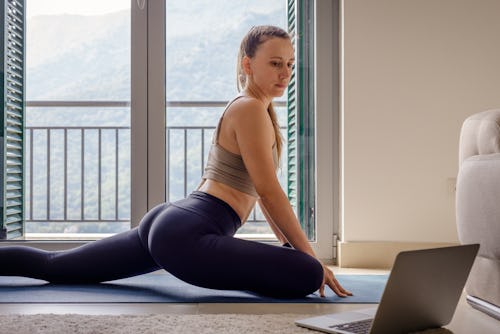
Once you’ve logged a few hours at your desk, you might start to notice that your hips are tight and your back is stiff. Oh, and maybe your glutes are a little achey, too. This is a common plight of anyone who sits throughout the day, which tends to be the case when you work from home. But because you’re aren’t in the office — and because you’re probably already wearing comfy clothes — you can easily pop onto a yoga mat for a quick, full-body stretch.
This is where pigeon pose comes into play. The popular yoga stretch is an ideal way to loosen tight hip, piriformis, and lower back muscles, says stretch therapist and pelvic health coach Leigha Verbeem. “The stretching of the piriformis is a game changer in the way your hips, low back, and pelvis feel overall,” Verbeem tells Bustle. Pigeon pose also effectively moves you out of a hunched seated position, she adds, so that your body doesn’t feel so “stuck.”
Pigeon pose can be good for you emotionally, too. “By sitting and breathing into the discomfort — not pain! — of the stretch, you are telling your mind that you can do hard tasks, that you can breathe your way through discomfort,” says Leah Ehinger, a licensed therapist and RYT-200hr yoga teacher. “When you get out of the pose, you’ll feel more flexible physically and mentally.” Not to mention ready to tackle your next round of emails.
What’s more, the stretch might even help release emotions that are thought to get stuck in the hips, Ehinger says. Pigeon pose brings awareness to this space, so that you can better cope with all your WFH stress. Here’s how to do pigeon pose, in case you’d like to add it to your routine.
How To Do Pigeon Pose
Ehinger recommends getting up from your desk to do pigeon pose at least once a day. Once you get into position, take deep breaths as yo.u hold the pose for a couple of minutes on each side, or until your aches and pains melt away. Here, Verbeem shares how to do pigeon pose with proper form.
- Start in a downward dog yoga pose, with your hips pointing up to the ceiling.
- Lift one leg into the air, then step it forward.
- Bend your leg and gently place your knee next to your wrist.
- Untuck your back toes and extend your other leg straight behind you. Go slow and ease into the stretch.
- If there’s a gap between your hips and the ground, place a block or blanket there.
- Reach your arms forward, press your palms into the mat, and elongate your spine.
- Walk your hands out to drape your body across your bent knee.
- Lower your head and reach.
For an easier stretch, remain propped up on your elbows and keep your forward knee bent. For a more intense stretch, keep your knee at 90 degrees, walk your hands out, and stretch your body across your knee.
How To Modify Pigeon Pose
If pigeon pose still feels too intense, Ehinger suggests lying on your back and pulling a leg up to your chest to stretch tight hip muscles. “Pigeon pose is also possible to do while sitting in a chair by crossing an ankle over a knee,” she says. “This will loosen up the hip and glute muscles that are often very sore and tight with people who sit often.”
Remember, you can also support your hips with a yoga block when doing full pigeon pose on the floor. “This is helpful to elevate the hips and to take some strain off the pose,” Ehinger says.
For a bigger stretch, get into the full pigeon pose on the floor and then play around with the position of your torso and upper body. It might feel good to rest your forearms or forehead on the ground, Ehinger says, or to extend your torso and arms up. “The next step for an even deeper stretch is to lift the back foot and reach for it,” she says.
Common Pigeon Pose Mistakes To Avoid
To avoid injury while in pigeon pose, check to make sure your front leg stays in the correct position. “Some people tend to rest their front leg on the shin, when it should actually be the side of the calf that touches the ground,” Verbeem says. “It's different for the back leg, though. You want the leg behind you to be shin down to the floor.”
Look down to see if your hips are square and even as well, instead of tilted to one side. “This is where using a yoga block is really helpful until you can sit comfortably on the ground,” Verbeem says.
And finally, resist the urge to contort your body or move too fast. “Don't force the stretch too much to the point of pain,” she adds. “And don't stress if your body can’t get deeper into the stretch! Just do what feels good and relax into it.” This is your mid-day yoga break, after all.
Sources:
Leigha Verbeem, stretch therapist, women's pelvic health coach, and personal trainer
Leah Ehinger, licensed therapist and RYT-200hr yoga teacher